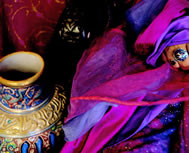




 |
    |
Reviews |
||
|
|
Dr. Moya CareyIn Carolinda Tolstoy's work, there appear traces and reflections of motifs from many contexts in Islamic art. Tolstoy borrows decorative elements and ideas from painting, manuscript-illumination, metalwork, ceramics and textiles. This is much in keeping with the versatile nature of surface-decoration in Islamic art, where there are constant interchanges of motifs between the media. Forms from Islamic art also recur: the finialled shape of Tolstoy's salt-kilns recalls cast brass incense-burners of medieval Iran and Syria. An enjoyment of patterned gold decoration, set against calm blues and pinks, is a persistent theme in Tolstoy's ceramics: this echoes the gold-stencilled decoration of dyed page margins in the luxury manuscripts of the Mughal emperors, in sixteenth and seventeenth century India. Shimmering lustre-painted objects occur in Islamic art from the ninth century onwards, manufactured according to a closely-guarded technique. Blends of silver and copper were used to enliven the surfaces of ceramics and glass with a metallic sheen. With a closer look at Tolstoy's gold patterns, elements from the stylised flowers of Iznik pottery (sixteenth-century Ottoman Turkey) can also be recognised, such as the dipping silhouettes of hibiscus flowers. Tolstoy's pale palette, laces with gold, is closest of all to the mature style of Safavid painting in seventeenth-century Iran. It is therefore unsurprising that she chooses to depict the typical Safavid figures on her ceramic pieces: idling lovers and loungers, relaxing in a landscape of pink and gold. © Dr. Moya Carey 1999
|
 |
| © Carolinda Tolstoy 1999-2018 | Web site design: QuincDigital |